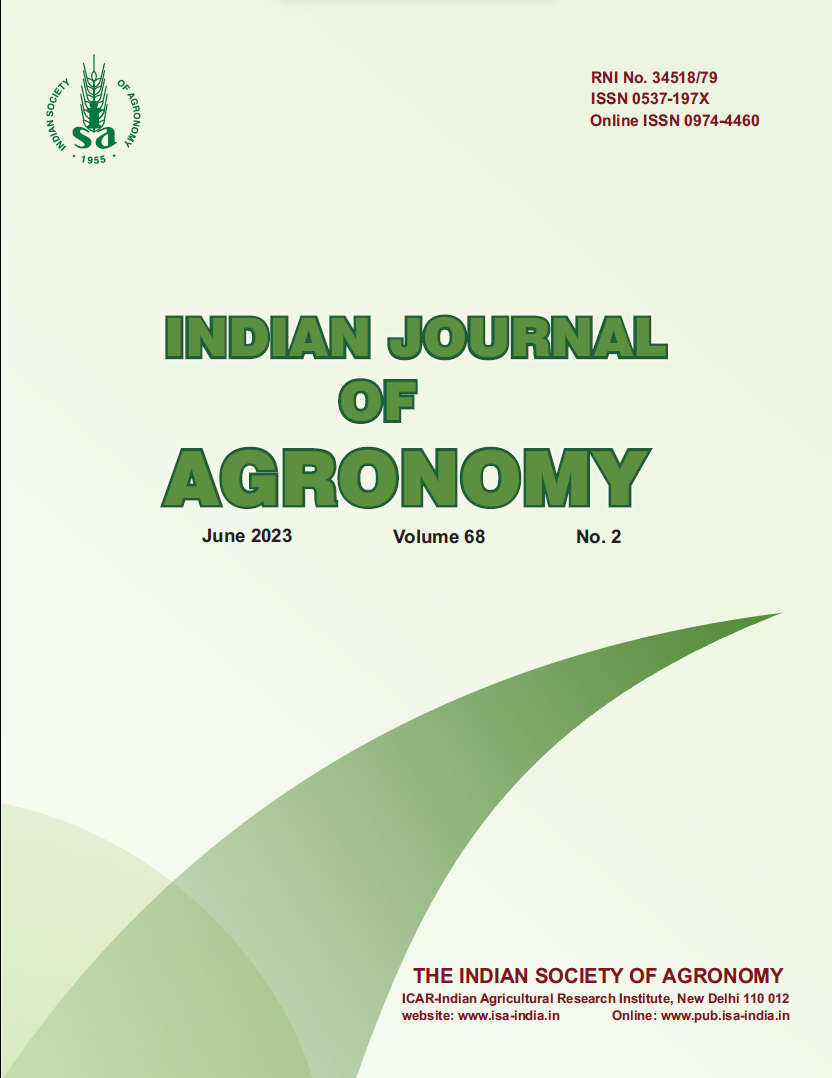Productivity and profitability of baby corn (Zea mays)-based cropping systems under various nutrient-management practices
DOI:
https://doi.org/10.59797/ija.v68i2.351Keywords:
Baby corn, Crop diversification, Intensified cropping systems, Nutrient-management, Sweet cornAbstract
A field experiment was conducted during 2016–17 to 2017–18 at the ICAR-Indian Agricultural Research Institute, New Delhi, to study the productivity and profitability of baby corn (Zea mays L.)-based cropping system under various cropping systems with different nutrient-management levels. The experiment was laid out in a split-plot design with 3 baby corn-based cropping systems (CSs) in main plots, viz. CS1 , rainy season baby corn-winter season baby corn-summer season baby corn (RBc – WBc – SBc); CS2 , RBc – WBc + vegetable fenugreek (Trigonella foenum-graecum L.) – summer season vegetable cowpea [Vigna unguiculata (L.) Walp.] (RBc – WBc + VFg – SCp); and CS3 , RBc – WBc + VFg – summer season sweet corn (RBc – WBc + VFg – SSc), and 5 nutrient-management levels, viz. N1 , 100% recommended dose of nitrogen (RDN) through urea fertilizer (100% RDN – F); N2, 75% RDN – F + 25% RDN through FYM (75% RDN –F + 25% RDN – FYM); N3 , 75% RDN – F + 25% RDN through vermicompost (75% RDN – F + 25% RDN – VC); N4 , 75% N % RDN – F + 25% N through leaf compost (75% RDN – F + 25% RDN – LC); and N5 , microbial consortium of Rhizobium/Azotobacter + phosphorus-solubilizing bacteria + potassium-solubilizing bacteria (R/Azo + PSB + KSB), in subplots. The yield of different component crops converted and presented in terms baby corn-equivalent yield (BCEY) for better understanding. Among the cropping systems, the BCEY differed from 1.99 to 2.18 Mg/ha during the rainy season. Baby corn CSs intensified with vegetable fenugreek during the winter season, resulted in significantly higher BCEY (2.42–2.52 Mg/ha) with CS2 and CS3 than the sole baby corn (CS1 ). Similarly, during the summer season, significantly higher BCEY (3.03–3.07 Mg/ ha) was recorded with CS3 . The cropping system CS2 recorded significantly lowest BCEY during both the years. The net returns in all CSs during rainy season was not differed significantly. During the winter season, significantly higher net returns (130–142 × 103 `/ha) were recorded in both the intensified cropping systems (CS2 and CS3 ) than CS1 (95–98 × 103 `/ha). During the summer season, significantly higher net returns (~186 × 103 `/ha) were recorded in CS3 than both CSs. Among the nutrient-management levels, significantly higher BCEY and net returns were recorded with 75% RDN – F + 25% RDN – FYM, followed by 75% RDN – F + 25% RDN – VC during both the years.
References
Babu, S., Mohapatra, K.P., Das, A., Yadav, G.S., Tahasildar, M., Singh, R., Panwar, A.S., Yadav, V. and Chandra, P. 2020.
Designing energy-efficient, economically sustainable and environmentally safe cropping system for the rainfed maize– fallow land of the Eastern Himalayas. Science of the Total Environment 722: 137874.
Chhetri, B. and Sinha, A.C. 2020. Advantage of maize (Zea mays)- based intercropping system to different nutrient management practices. Indian Journal of Agronomy 65(1): 25–32.
Gomez, K.A. and Gomez, A.A.1984. Statistical Procedures for Agricultural Research, edn 2, An International Rice Research Institute Book; Wiley Inter-Science Publication, John Wiley & Sons, New York.
Joshi, E., Vyas, A.K., Dhar, S., Dass, A., Sasode, D.S., Prajapati, K., Jinger, D., Singhal, V., Gupta, G. and Prasad, D. 2021. Soil microbial biomass carbon and soil enzymatic activity under nutrient omission plot technique in maize (Zea mays)–wheat (Triticum aestivum) cropping system. Indian Journal of Agronomy 66(2): 170–179.
Kumar, A. and Dhar, S. 2010. Evaluation of organic and inorganic sources of nutrients in maize (Zea mays) and their residual effect on wheat (Triticum aestivum) under different fertility levels. Indian Journal of Agricultural Sciences 80(5): 364–71.
Preetham, R., Kumar, Avil K., Srinivas, A., Manohar Rao, A. and Ramprakash, T. 2021. Influence of nutrient-management practices on production, profitability and energetics of baby corn (Zea mays)–hyacinth bean (Lablab purpureus var. typicus) cropping system. Indian Journal of Agronomy 66(2): 180–185.
Sharma, N.K., Singh, R.J., Mandal, D., Kumar, A., Alam, N.M. and Keesstra, S. 2017. Increasing farmer’s income and reducing soil erosion using intercropping in rainfed maize–wheat rotation of Himalaya. India. Agriculture, Ecosystems and Environment 247: 43–53.
Yadav, G.S., Babu, S., Das, A., Datta, M., Mohapatra, K.P., Singh, R., Singh, V.K., Rathore, S.S. and Chakraborty, M. 2021. Productivity, soil health, and carbon management index of Indian Himalayan intensified maize-based cropping systems under live mulch-based conservation tillage practices. Field Crops Research 264: 108080.






